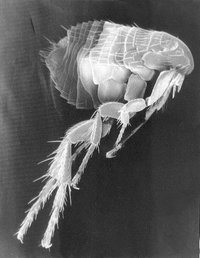Flea
|
|
| Fleas | ||||||||||||||||||
|---|---|---|---|---|---|---|---|---|---|---|---|---|---|---|---|---|---|---|
 SEM micrograph of a flea | ||||||||||||||||||
| Scientific classification | ||||||||||||||||||
| ||||||||||||||||||
| Families | ||||||||||||||||||
|
Tungidae - Sticktight and Chigoe fleas |
Flea is the common name for any of the small wingless insects of the order Siphonaptera. Fleas are external parasites, living off the blood of mammals and birds.
Note: There is also a genus of Protozoa named Siphonaptera
Some well known flea species include:
- Cat Flea (Ctenocephalides felis),
- Dog Flea (Ctenocephalides canis),
- Northern Rat Flea (Nosopsyllus fasciatus),
- Oriental Rat Flea (Xenopsylla cheopis).
Flea_bites.jpg
In most cases fleas are just a nuisance to their hosts, but some people and some animals suffer allergic reactions to flea saliva resulting in rashes. Flea bites generally result in the formation of a slightly-raised swollen itching spot with a single puncture point at the center.
However, fleas can transmit disease. One devastating example of this was the bubonic plague, transmitted between rodents and humans. Murine typhus (endemic typhus) fever, and in some cases tapeworms can also be transmitted by fleas.
Life Cycle
HookeFlea01.jpg
Fleas pass through a complete life cycle consisting of egg, larva, pupa and adult. Completion of the life cycle from egg to adult varies from two weeks to eight months depending on the temperature, humidity, food, and species. Normally after a blood meal, the female flea lays about 15 to 20 eggs per day – up to 600 in its lifetime – usually on the host (dogs, cats, rats, rabbits, mice, squirrels, chipmunks, raccoons, opossums, foxes, chickens, humans, etc.). Eggs loosely laid in the hair coat drop out almost anywhere, especially where the host rests, sleeps or nests (rugs, carpets, upholstered furniture, cat or dog boxes, kennels, sand boxes, etc.).
Eggs hatch between two days to two weeks into larvae found indoors in and along floor cracks, crevices, along baseboards, under rug edges and in furniture or beds. Outdoor development occurs in sandy gravel soils (moist sand boxes, dirt crawlspace under the house, under shrubs, etc.) where the host may rest or sleep. Sand and gravel are very suitable for larval development which is the reason fleas are erroneously called "sand fleas."
Larvae are blind, avoid light, pass through three larval instars and take a week to several months to develop. Their food consists of digested blood from adult flea feces, dead skin, hair, feathers, and other organic debris; larvae do not suck blood. Pupae mature to adulthood within a silken cocoon woven by the larva to which pet hair, carpet fiber, dust, grass cuttings, and other debris adheres. In about five to fourteen days, adult fleas emerge or may remain resting in the cocoon until the detection of vibration (pet and people movement), pressure (host animal lying down on them), heat, noise, or carbon dioxide (meaning a potential blood source is near). Most fleas overwinter in the larval or pupal stage with survival and growth best during warm, moist winters and spring.
Flea bites (http://www.flea-i.com/flea-bites.html) can be treated with Calamine Lotion.
